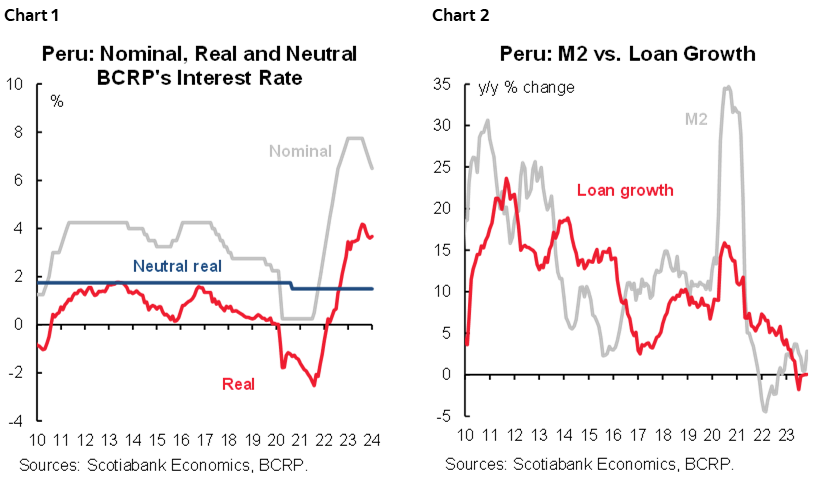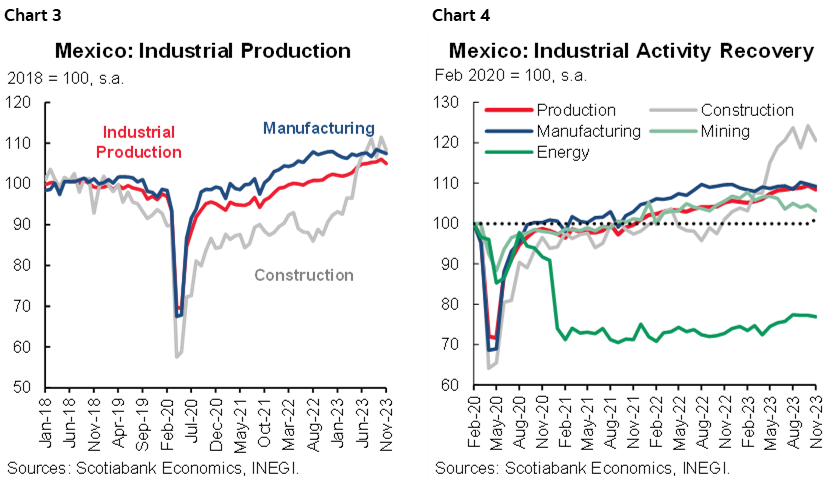- Peru: Rates forecast update—we see more cuts in 2024, inflation under control
- Mexico: Industrial production recorded a smaller increase in November as manufacturing contracted
PERU: RATES FORECAST UPDATE—WE SEE MORE CUTS IN 2024, INFLATION UNDER CONTROL
Our 2024 rates forecast now assumes cuts totaling 250bps, higher than the 200bps we projected previously. This means a terminal rate of 4.25% instead of 4.75%. Our base case now contemplates recurring cuts of 25bps per meeting until Q4-24, when we expect a pause once the real rate approaches the neutral level of 2%.
The board of Central Bank of Peru (BCRP) cut its key interest rate on Thursday, January 11th by 25bps, to 6.50%, in line with what was expected by market consensus, the Bloomberg median, and our forecast at Scotiabank. In its statement, the BCRP once again emphasized that the rate cut “would not necessarily imply a cycle of successive cuts in the key rate,” although the possibility of a pause in the short term is increasingly less, due to weaker signs of El Niño and because inflation would return to the target range sooner than expected.
The BCRP statement emphasized that both core inflation and 12-month inflation expectations are already within the target range (between 1% and 3%) and reaffirmed the forecast that headline inflation will reach the target range within the next few months. This message confirms what Governor Velarde previously said about inflation being under control. Core inflation returned to the target range in December 2023, standing at 2.9%, after 24 months of remaining outside; while 12-month inflation expectations fell from 3.2% to 2.8% in their last reading, returning to the target range after 29 months of remaining outside.
The statement reiterated that since June 2023, a more marked downward trend in inflation has been observed, as some of the transitory effects due to supply restrictions dissipate. This reversal of supply shocks has been greater than expected. The first inflation readings for January suggest that the return to the target range would occur sooner than expected, after 31 months of remaining outside. These new conditions lead us to review our 2024 inflation forecast from 3.5% to 2.4%. This new forecast considers a weak impact of El Niño on food prices—due to greater agricultural supply—and a moderate recovery in consumption—mainly gastronomic. Likewise, it includes the update of controlled prices—such as water prices—and indexed prices—education—and a relatively stable FX rate. Likewise, it considers fuel prices that would continue low in line with a 2024 average oil price expected by Scotiabank of US $81 per barrel. Core inflation would approach 2.5%, remaining within the target range. In this regard, in its December report the BCRP reduced its inflation forecast for this year from 2.4% to 2.3% and aimed at 2.0% for 2025.
The BCRP warned that leading indicators and expectations about the economy improved moderately in December, but the majority remained in the pessimistic range. The macroeconomic expectations survey reflects that the 2024 GDP growth forecast remained stable at 2.3%, in line with our forecast. The sea temperature anomaly continues to reduce in the first readings of 2024, due to which the intensity of El Niño continues to weaken, which is favourable for economic recovery. In line with this, the BCRP expects a recovery of the economy, projecting a growth of 3%, because it expects a moderate impact from El Niño and no longer strong, and due to the reversal of the supply shocks of 2023. Governor Velarde has indicated that this recovery would be visible even from 2024-1Q (+0.7%)
Despite the cut in the policy rate to 6.50%, the real interest rate went from 3.6% to 3.7% (chart 1), maintaining the restrictive stance of monetary policy, and still well above of the neutral level (2.00%), accumulating 17 months of contractive territory. The monetary policy stance was maintained by reaffirming that, “if necessary, it will consider additional modifications to monetary policy.” Based on our new inflation view, our rates forecast for 2024 now assumes a cut of 250bps throughout the year, greater than the 200bps previously forecast, to 4.25%. Our base case now contemplates recurring cuts of 25bps per meeting until 2024-4Q, when we expect a pause once the real rate approaches the neutral level of 2%. Monetary conditions showed a slight recovery in November, reflected in an expansion of liquidity (+0.3% y/y, after four months in negative territory) and in a slight recovery of loans (+0.1% y/y, after two months with zero variation), see chart 2. This trend would be more visible in the future, as the cycle of interest rate cuts continues.

—Mario Guerrero
MEXICO: INDUSTRIAL PRODUCTION RECORDED A SMALLER INCREASE IN NOVEMBER AS MANUFACTURING CONTRACTED
In November, industrial production rose to 2.8% y/y from 5.6% previously. Construction slowed down 18.0% (28.1% previously), utilities 5.5% (6.8% previously), while manufacturing fell -0.3% (1.1% previously) and mining -2.3% (0.1% previously). In the monthly comparison, Industrial activity decreased -1.0% m/m from 0.6% previously, seasonally adjusted. Construction dropped -2.9%, manufacturing -0.5%, while utilities decreased -0.4%, and mining -1.4%. On the other hand, in the cumulative period from January to November production printed a real annual increase of 3.8% YTD (charts 3 and 4).

Construction has already reached its highest annual pace in August, when it increased 30.0% y/y, and in the coming months it may increase still vigorously, but to a lesser magnitude. Within this component, an increase of 15.4% YTD was observed in the January–November period, highlighting the construction of civil engineering works at 79.1%.
It is also worth noting that manufacturing has been perceived as weak in recent months, in line with the situation in the US sector, and related to the strength of imported goods in Mexico. The exception to this is the transport manufactures, with a 10.0% YTD increase in real terms. Even so, the cumulative increase of manufactures remains at 1.3%, and the components with the worst performance have been wood products, textiles and clothing, as well as beverages and tobacco.
We expect the index to continue reporting annual increases, although to a lesser extent, with a moderate slowdown in construction, and a rebound in manufacturing pending on the consolidation of projects due to nearshoring.
—Brian Pérez & Miguel Saldaña
DISCLAIMER
This report has been prepared by Scotiabank Economics as a resource for the clients of Scotiabank. Opinions, estimates and projections contained herein are our own as of the date hereof and are subject to change without notice. The information and opinions contained herein have been compiled or arrived at from sources believed reliable but no representation or warranty, express or implied, is made as to their accuracy or completeness. Neither Scotiabank nor any of its officers, directors, partners, employees or affiliates accepts any liability whatsoever for any direct or consequential loss arising from any use of this report or its contents.
These reports are provided to you for informational purposes only. This report is not, and is not constructed as, an offer to sell or solicitation of any offer to buy any financial instrument, nor shall this report be construed as an opinion as to whether you should enter into any swap or trading strategy involving a swap or any other transaction. The information contained in this report is not intended to be, and does not constitute, a recommendation of a swap or trading strategy involving a swap within the meaning of U.S. Commodity Futures Trading Commission Regulation 23.434 and Appendix A thereto. This material is not intended to be individually tailored to your needs or characteristics and should not be viewed as a “call to action” or suggestion that you enter into a swap or trading strategy involving a swap or any other transaction. Scotiabank may engage in transactions in a manner inconsistent with the views discussed this report and may have positions, or be in the process of acquiring or disposing of positions, referred to in this report.
Scotiabank, its affiliates and any of their respective officers, directors and employees may from time to time take positions in currencies, act as managers, co-managers or underwriters of a public offering or act as principals or agents, deal in, own or act as market makers or advisors, brokers or commercial and/or investment bankers in relation to securities or related derivatives. As a result of these actions, Scotiabank may receive remuneration. All Scotiabank products and services are subject to the terms of applicable agreements and local regulations. Officers, directors and employees of Scotiabank and its affiliates may serve as directors of corporations.
Any securities discussed in this report may not be suitable for all investors. Scotiabank recommends that investors independently evaluate any issuer and security discussed in this report, and consult with any advisors they deem necessary prior to making any investment.
This report and all information, opinions and conclusions contained in it are protected by copyright. This information may not be reproduced without the prior express written consent of Scotiabank.
™ Trademark of The Bank of Nova Scotia. Used under license, where applicable.
Scotiabank, together with “Global Banking and Markets”, is a marketing name for the global corporate and investment banking and capital markets businesses of The Bank of Nova Scotia and certain of its affiliates in the countries where they operate, including; Scotiabank Europe plc; Scotiabank (Ireland) Designated Activity Company; Scotiabank Inverlat S.A., Institución de Banca Múltiple, Grupo Financiero Scotiabank Inverlat, Scotia Inverlat Casa de Bolsa, S.A. de C.V., Grupo Financiero Scotiabank Inverlat, Scotia Inverlat Derivados S.A. de C.V. – all members of the Scotiabank group and authorized users of the Scotiabank mark. The Bank of Nova Scotia is incorporated in Canada with limited liability and is authorised and regulated by the Office of the Superintendent of Financial Institutions Canada. The Bank of Nova Scotia is authorized by the UK Prudential Regulation Authority and is subject to regulation by the UK Financial Conduct Authority and limited regulation by the UK Prudential Regulation Authority. Details about the extent of The Bank of Nova Scotia's regulation by the UK Prudential Regulation Authority are available from us on request. Scotiabank Europe plc is authorized by the UK Prudential Regulation Authority and regulated by the UK Financial Conduct Authority and the UK Prudential Regulation Authority.
Scotiabank Inverlat, S.A., Scotia Inverlat Casa de Bolsa, S.A. de C.V, Grupo Financiero Scotiabank Inverlat, and Scotia Inverlat Derivados, S.A. de C.V., are each authorized and regulated by the Mexican financial authorities.
Not all products and services are offered in all jurisdictions. Services described are available in jurisdictions where permitted by law.

